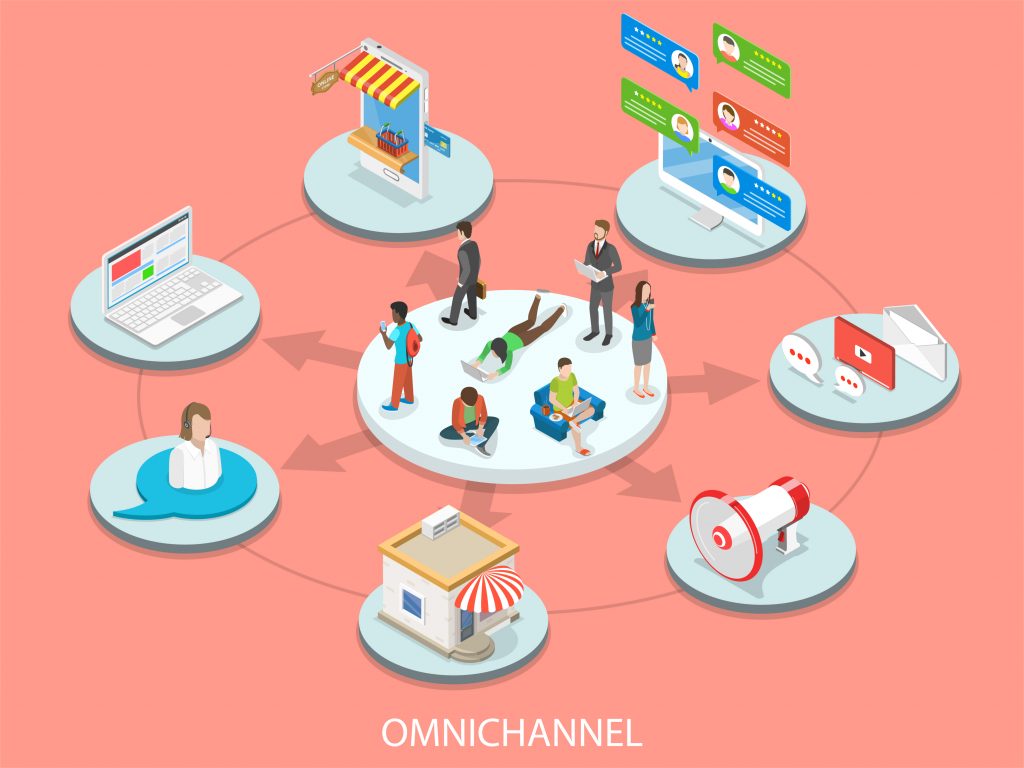

What is Omnichannel? 6 Essential Technologies in Customer Service
Many businesses pride themselves on being multi-channel. But if customers have to repeat information as they switch channels, or if their experience is inconsistent, it’s still just a separate effort. Omnichannel goes a step further: it connects all channels, creating a seamless, consistent, and personalized experience flow for each customer, no matter where and when they interact.

What is Omni-channel?
Omni-channel is a customer care model that seamlessly integrates across multiple interaction channels. Instead of each channel operating independently, omni-channel gathers data and experiences from channels (website, Mobile, store, Social, Call center, chatbot ...) into a single system. When customers switch between channels, they will not lose context: for example, sending an email on Monday, calling on Tuesday will continue to be processed on the same spot as before.
The operating principle of omni-channel is to maintain a common customer information profile and a unified processing flow, from which customers have a consistent and seamless experience across all touchpoints that the business provides.
The Difference Between Omni-channel and Multi-channel

| Characteristic |
Multi-channel |
Omni-channel |
|---|---|---|
| System integration | Communication channels operate independently and do not share data. | All channels integrated on a single platform |
| Customer Experience | Each channel is separate the experience is not synchronized. | Consistent experience: consistent messaging and branding across channels |
| Preserve context | No: the customer has to repeat the information when changing channels. | Yes: keep context between channels, guests don't need to be reminded when transitioning |
In short, multi-channel is simply being present on multiple channels but each channel acts as a “single unit”, while omni-channel connects channels into a unified system. Omni-channel focuses on the customer: making the customer not see the channels as separate but perceive the brand as a connected whole.
Benefits of Omni-channel in customer care
Omni-channel implementation brings many benefits to businesses:
Increase customer understanding
Data from all interactions (email, chat, social networks, stores, etc.) is centralized, helping to analyze customer behavior and needs better. Businesses can easily recognize trends and adjust products/services promptly.
Increase sales and satisfaction
A seamless shopping experience makes it easy for customers to complete transactions. Customers feel respected for their time when issues are resolved quickly and on their preferred channel. Many surveys show that customers prefer to self-serve via chatbots, leading to higher satisfaction.
Improve employee productivity and motivation
Automated processes (chatbots, FAQs, quick response features) free employees from repetitive simple questions, allowing them to focus on more complex issues. Employees trained in multi-channel support feel more meaningful in their work, thereby better engaging with the company
Saving costs
Investing in omni-channel technology optimizes the care process, reducing the load on traditional call centers, helping to reduce operating costs
Create a competitive advantage
Omni-channel is now the standard trend in CX. Providing a differentiated experience enhances the brand. Investing in omni-channel helps businesses stand out and retain loyal customers better
Common challenges when implementing Omni-channel

Omni-channel implementation also poses major challenges:
Complex technology integration: Legacy systems are often not designed to easily connect to new channels (chat, social media, chatbots, POS systems, etc.). Upgrading or replacing them is costly and can disrupt operations
Data fragmentation: Each channel stores its own customer data, making it difficult to synthesize a single view. Setting up a centralized data warehouse and synchronizing information across systems requires high technical effort
Training and workforce management: Customer service staff need to be trained to multitask across multiple channels. Each channel has its own characteristics (e.g. chat requires quick responses, email requires standard wording, etc.), so continuous training is needed to ensure staff competency
Consistent service quality: Maintaining consistent service levels across online and offline channels is difficult. For example, the standard for responding to customers via social media must be the same when calling or meeting in person. Businesses must build standards and track KPIs across channels to ensure consistency
Change processes and organizations: Omni-channel requires breaking down boundaries between departments (sales, marketing, logistics, customer service, etc.). This is the most difficult “cultural” issue, because each department needs to work collaboratively, share data and common goals
Large investment resources: Businesses must invest heavily in technology (CRM, data integration, chatbot platforms, etc.) and long-term human resources. The time to build an integrated system can be long, especially for large businesses. Initial business performance can be difficult to measure immediately, because it is necessary to change the way revenue is evaluated on each channel. Many companies recommend implementing according to a roadmap (first focusing on 2-3 key channels, then expanding) and building a new synchronized measurement system suitable for omni-channel
Popular Omnichannel support technology

To realize omni-channel, companies often use many modern technology solutions:
1. Multi-channel CRM system
As a center for storing customer information and workflow. CRM platforms (Salesforce, Microsoft Dynamics, Zendesk, SAP, Zoho...) support integrating data from email, phone, social networks, stores... into a single interface. Omni CRM integrates both artificial intelligence (AI) and chatbots, automating processes, reducing manual work for employees.
2. Chatbots and Virtual Assistants
AI chatbots help automatically answer frequently asked questions, communicate 24/7 on websites, Facebook Messenger, Zalo... Many modern chatbot solutions are deeply integrated with CRM and internal systems, and can route customers to the right employee or channel.
3. Omni-channel Contact Center Software
Many businesses deploy omni-channel call center solutions (Worldfone, Genesys, Avaya, Twilio Flex, Cisco, Amazon Connect…) to simultaneously manage messages, emails, live chats, phone calls… in one platform. Features such as smart routing, IVR, recording storage help connect employees and customers seamlessly.
4. Data integration system (Middleware/iPaaS)
Data integration solutions (ETL, API Gateway, iPaaS such as MuleSoft, Zapier, Workato…) help connect separate systems (CRM, ERP, POS, warehouse, online channels) to synchronize customer information and orders in real time.
5. AI and Data Analytics
AI helps predict customer needs, personalize experiences and allocate resources. For example, the system suggests products based on purchase history; the algorithm recommends the right birthday deals. Big Data analysis helps make strategic decisions.
6. Communication channel integration platform
Multi-channel messaging solutions help connect Facebook inbox, email, Zalo, SMS... and synchronize customer communication history on the same employee interface.
Omni-channel Performance Metrics and Measurements
Measuring omni-channel performance requires a combination of operational and customer experience KPIs:
First Call Resolution (FCR): Measures the percentage of customer issues that are resolved immediately upon first contact (via phone, chat or email). This metric measures the effectiveness of customer support, and if high, saves time for customers and businesses.
Customer Satisfaction Score (CSAT): Determined by surveying immediately after the issue is resolved. For example, let customers rate their satisfaction on a scale of 1-5 or through emoticons. CSAT directly reflects customers' perceptions of service quality.
Net Promoter Score (NPS): The percentage of customers who are willing to recommend the brand to others. A high NPS indicates an overall positive customer rating. Businesses often measure NPS periodically through surveys.
Response and Resolution Time: Metrics such as First Response Time and Average Handling Time help assess the speed of handling requests. Omnichannel can analyze the time spent on each channel (chat, email, phone) to optimize.
Conversion Rate: Measures how many percent of omni-channel customers make a purchase decision (applies to e-commerce or upsell). Omni-channel aims to improve conversion rates by keeping customers on the journey.
Abandonment Rate: For example, the percentage of chat/phone customers who leave before receiving support. Reducing this metric shows better ongoing customer support.
Customer Lifetime Value and ROI: Long-term measurements such as customer profit (CLTV) and return on investment when implementing omni-channel. ROI calculations can be based on comparing increased revenue and reduced processing costs after applying omni-channel.
Ticket Volume and Channel Coverage: Evaluate the volume of requests through each channel (chat, email, phone, social media, etc.), the proportion of self-service channels. This shows the preferred channel trend and the ability to serve multiple channels.
In general, business indicators (CSAT, NPS) combined with operational indicators (FCR, processing time, rejection rate) will reflect the overall effectiveness of omnichannel services. CRM tools or integrated data analytics help businesses collect this data across all channels.
Omni-channel in customer care is an inevitable trend in the digital age, helping businesses meet customers' strict expectations for seamlessness and convenience. Although it requires a large investment in technology and organization, the results (increased satisfaction, cost savings, and competitive advantage) bring good returns in the long term. Successfully implementing omni-channel requires a clear strategy, integrated data systems, and a flexible internal culture. Businesses today often start implementing it step by step (prioritizing the most important channels first) and continuously measure to optimize service. When done well, omni-channel not only improves the customer experience, but also helps businesses capture a more dynamic market and retain loyal customers effectively.
Blog relate to
Professional Customer Service Solution Contact Center as a Service (CCaaS)
April 14, 2025
Giải pháp tối ưu lắp đặt tổng đài cho công ty có nhiều chi nhánh
December 26, 2025
What is Virtual PBX? 7 reasons to choose a virtual switchboard for businesses
December 26, 2025


